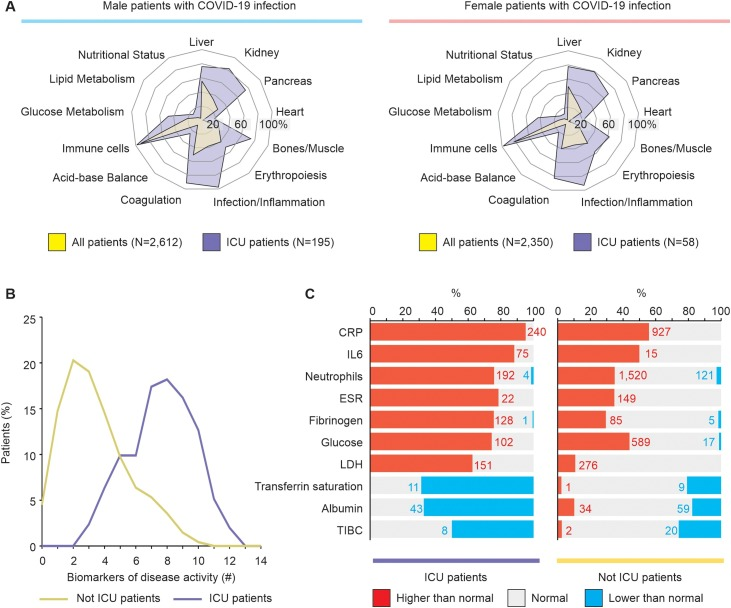In-depth analysis of laboratory parameters reveals the interplay between sex, age, and systemic inflammation in individuals with COVID-19.
The progression and severity of COVID-19 varies significantly in the population. While the hallmarks of SARS-CoV-2 and severe COVID-19 within routine laboratory parameters are emerging, the impact of sex and age on these profiles is still unknown. We performed multidimensional analysis of millions of records of laboratory parameters and diagnostic tests for 178,887 individuals from Brazil, of which 33,266 tested positive for SARS-CoV-2. These included complete blood cell count, electrolytes, metabolites, arterial blood gases, enzymes, hormones, cancer biomarkers, and others. COVID-19 induced similar alterations in laboratory parameters in males and females. CRP and ferritin were increased especially in older men with COVID-19, whereas abnormal liver function tests were common across several age groups, except for young women. Low peripheral blood basophils and eosinophils were more common in the elderly with COVID-19. Both male and female COVID-19 patients admitted to intensive care units displayed alterations in the coagulation system, and higher values of neutrophils, CRP and lactate dehydrogenase. Our study uncovers the laboratory profile of a large cohort of COVID-19 patients that underly discrepancies influenced by aging and biological sex. These profiles directly link COVID-19 disease presentation to an intricate interplay between sex, age and immune activation.
Authors
Felipe Ten-Caten; Patrícia Gonzalez-Dias; Ícaro Castro; Rodrigo L T Ogava; Jeevan Giddaluru; Juan Carlo S Silva; Felipe Martins; André N A Gonçalves; André G Costa-Martins; José D Araujo; Ana Carolina Viegas; Fernando Q Cunha; Sandra Farsky; Fernando A Bozza; Anna S Levin; Pia S Pannaraj; Thushan I de Silva; Paola Minoprio; Fabiano Pinheiro da Silva; Bruno B Andrade; Helder I Nakaya
External link
Publication Year
Publication Journal
Associeted Project
Network & Precision Medicine
Lista de serviços
-
Gene regulatory and signaling networks exhibit distinct topological distributions of motifs.Gene regulatory and signaling networks exhibit distinct topological distributions of motifs.
-
Gene signatures of autopsy lungs from obese patients with COVID-19.Gene signatures of autopsy lungs from obese patients with COVID-19.
-
Network Medicine: Methods and ApplicationsNetwork Medicine: Methods and Applications
-
ACE2 Expression Is Increased in the Lungs of Patients With Comorbidities Associated With Severe COVID-19.ACE2 Expression Is Increased in the Lungs of Patients With Comorbidities Associated With Severe COVID-19.
-
Drug repositioning for psychiatric and neurological disorders through a network medicine approach.Drug repositioning for psychiatric and neurological disorders through a network medicine approach.
-
Linking proteomic alterations in schizophrenia hippocampus to NMDAr hypofunction in human neurons and oligodendrocytes.Linking proteomic alterations in schizophrenia hippocampus to NMDAr hypofunction in human neurons and oligodendrocytes.
-
In-depth analysis of laboratory parameters reveals the interplay between sex, age, and systemic inflammation in individuals with COVID-19.In-depth analysis of laboratory parameters reveals the interplay between sex, age, and systemic inflammation in individuals with COVID-19.
-
The evolution of knowledge on genes associated with human diseasesThe evolution of knowledge on genes associated with human diseases
-
Network vaccinology.Network vaccinology.
-
Pyruvate kinase M2 mediates IL-17 signaling in keratinocytes driving psoriatic skin inflammationPyruvate kinase M2 mediates IL-17 signaling in keratinocytes driving psoriatic skin inflammation
-
Transcriptome analysis of six tissues obtained post-mortem from sepsis patientsTranscriptome analysis of six tissues obtained post-mortem from sepsis patients
-
Gene Signatures of Symptomatic and Asymptomatic Clinical-Immunological Profiles of Human Infection by Leishmania (L.) chagasi in Amazonian BrazilGene Signatures of Symptomatic and Asymptomatic Clinical-Immunological Profiles of Human Infection by Leishmania (L.) chagasi in Amazonian Brazil
-
In vitro morphological profiling of T cells predicts clinical response to natalizumab therapy in patients with multiple sclerosis.In vitro morphological profiling of T cells predicts clinical response to natalizumab therapy in patients with multiple sclerosis.
-
Integrative immunology identified interferome signatures in uveitis and systemic disease-associated uveitis.Integrative immunology identified interferome signatures in uveitis and systemic disease-associated uveitis.
-
Gene regulatory networks analysis for the discovery of prognostic genes in gliomas.Gene regulatory networks analysis for the discovery of prognostic genes in gliomas.
-
Revealing shared molecular drivers of brain metastases from distinct primary tumors.Revealing shared molecular drivers of brain metastases from distinct primary tumors.

